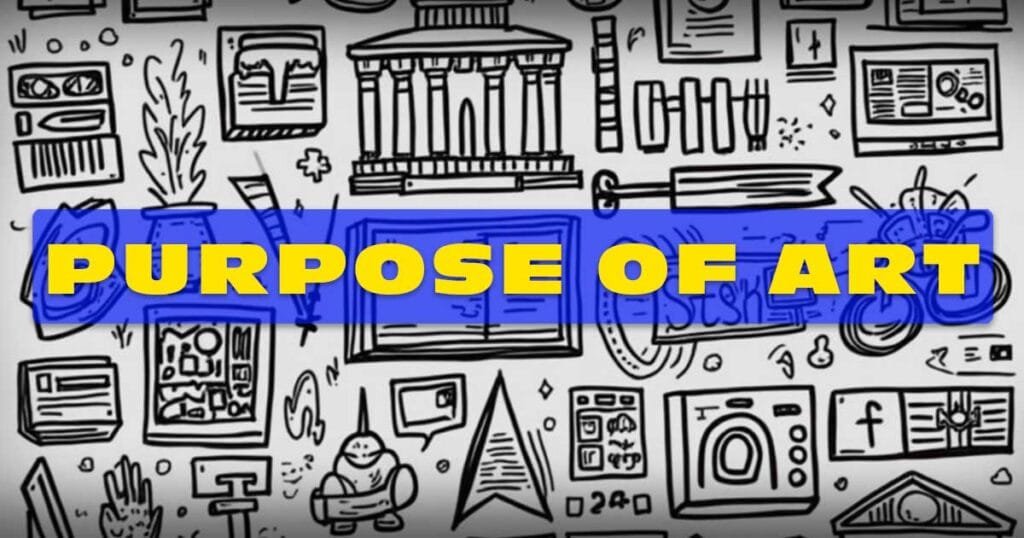Art has been a fundamental part of human culture and society throughout history, serving numerous purposes that go beyond mere aesthetics. The purpose of art varies depending on context, intention, and the perspective of the creator and audience. Here’s a detailed explanation of the many roles art plays:

1. Communication
Art serves as a powerful tool for communication, allowing people to express ideas, emotions, and experiences that might be difficult to articulate with words. Through visual imagery, music, or performance, artists convey complex narratives and feelings.
- Example: Picasso’s Guernica communicates the horrors of war without using words, resonating emotionally with viewers worldwide.
2. Emotional Expression and Catharsis
Art allows both artists and audiences to process and release emotions. It provides a therapeutic outlet for feelings of joy, sorrow, anger, or hope, often leading to emotional healing.
- Example: Van Gogh’s Starry Night reflects his inner turmoil and emotional depth, offering a window into his mental state.
3. Cultural and Historical Documentation
Art preserves cultural heritage and serves as a historical record, capturing the values, traditions, and events of a particular time and place. It offers future generations insight into past societies and ideologies.
- Example: Ancient Egyptian murals and sculptures document their religious beliefs and societal structures.
4. Aesthetic Pleasure
One of the primary purposes of art is to create beauty and provide visual or sensory enjoyment. Aesthetically pleasing art can uplift, inspire, and add joy to everyday life.
- Example: Claude Monet’s impressionist paintings, such as Water Lilies, provide serene and calming beauty.
5. Inspiration and Motivation
Art has the power to inspire individuals and societies to think differently, dream bigger, or act courageously. It often sparks innovation and encourages people to pursue creative endeavors.
- Example: Martin Luther King Jr.’s speeches were amplified by powerful protest songs like “We Shall Overcome,” inspiring civil rights movements.
6. Social and Political Advocacy
Art challenges societal norms, questions authority, and brings attention to injustices. It can serve as a platform for activism, provoking thought and inspiring change.
- Example: Banksy’s street art critiques capitalism, consumerism, and political corruption, sparking global conversations.
7. Self-Expression and Identity
For artists, creating art is often an exploration of their identity, beliefs, and personal experiences. It serves as a medium for self-discovery and connection with others who share similar emotions or ideas.
- Example: Frida Kahlo’s self-portraits reflect her struggles with physical pain and emotional hardship, as well as her cultural identity.
8. Entertainment and Leisure
Art also fulfills the purpose of entertaining and providing enjoyment. Movies, music, theater, literature, and visual arts all offer ways for people to relax, escape, and find pleasure.
- Example: Blockbuster films, like The Lord of the Rings, entertain while transporting audiences to fantastical worlds.
9. Spiritual and Religious Significance
Art has been closely tied to spirituality and religion throughout history. It is often used to express faith, tell religious stories, or create sacred spaces that inspire reverence and reflection.
- Example: Michelangelo’s The Sistine Chapel Ceiling portrays biblical scenes that resonate with spiritual awe.
10. Education and Knowledge
Art serves as an educational tool, simplifying complex ideas, spreading knowledge, and encouraging curiosity. Visual and performative storytelling can make learning more engaging and memorable.
- Example: Indigenous cave paintings served as educational tools to pass down knowledge about hunting and survival.
11. Exploration and Innovation
Art pushes boundaries and explores new possibilities, often leading to innovation in technique, material, or concept. It’s a space for experimentation that contributes to advancements in technology, culture, and thought.
- Example: The evolution from classical art to abstract and digital art reflects ongoing experimentation and redefinition of art.
12. Social Cohesion and Community Building
Art brings people together, fostering community and shared experiences. Public art, festivals, and collaborative projects strengthen social bonds and celebrate collective identity.
- Example: Community murals often reflect local culture and values while involving residents in their creation.
13. Meditation and Reflection
Art invites viewers to pause, reflect, and engage in introspection. It can create moments of stillness and mindfulness, encouraging deeper thinking and appreciation of life.
- Example: Zen gardens in Japan are designed as works of art that inspire meditation and contemplation.
14. Escapism
Art provides a means of escape from the stresses and hardships of daily life. It allows individuals to immerse themselves in imaginary worlds, stories, or experiences, offering solace and mental relaxation.
- Example: Fantasy novels like J.R.R. Tolkien’s The Hobbit transport readers to another realm, offering a break from reality.
15. Provoking Thought and Challenging Perceptions
Art challenges people to question their beliefs, explore alternative perspectives, and think critically. It can provoke debate and encourage intellectual engagement.
- Example: Marcel Duchamp’s Fountain (a repurposed urinal) questioned the very definition of art and sparked discussions about its meaning.
16. Economic Contribution
Art contributes to the economy through industries like fashion, film, music, and tourism. It creates jobs, promotes commerce, and supports local and global economies.
- Example: Cities like Paris and New York thrive on art-related industries, from galleries to entertainment.
Conclusion
The purpose of art is as diverse as humanity itself. It transcends boundaries, reflecting and shaping our world. Whether through personal expression, cultural preservation, or societal transformation, art enriches life, making it more meaningful, beautiful, and interconnected.
Also Read : What Is Art? Understand Deeply
Also Read : Art and Society | A Detailed Exploration
Also Read : What is Cinema? Understand Correctly
Frequently Asked Questions
Why is art important to society?
Answer: Art is vital to society because it reflects cultural values, fosters social cohesion, and inspires change. It provides a platform for dialogue, preserves traditions, and enhances mental well-being by offering creative and emotional outlets.
What role does art play in education?
Answer: Art enhances education by promoting creativity, critical thinking, and problem-solving skills. It helps students express themselves, understand diverse perspectives, and engage more deeply with subjects like history, science, and literature.
Does art always have to serve a purpose?
Answer: Not necessarily. Art can exist simply for aesthetic enjoyment or personal expression without a specific goal. However, even “purposeless” art often evokes emotions or provokes thought.

